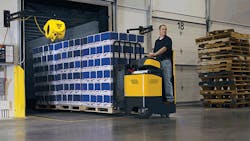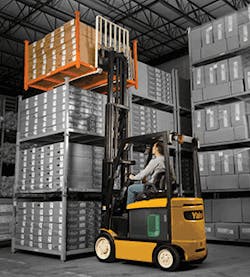Distribution center (DC) managers are charged with delivering on increasingly ambitious service-level agreements for consumer deliveries and retail replenishment. The need for efficiency, accuracy and flexibility has never been greater. With the advent of the Internet of Things and Big Data, operations have more data than ever to assess performance.
Operational metrics enable DCs to identify latent inefficiencies and take better control of operations for improved performance when handling the peaks and daily challenges of distribution and fulfillment.
The key now is to identify the DC metrics that provide the greatest value in shaping business strategy and operations to drive customer satisfaction. This article includes insights from the Warehousing Education and Research Council (WERC) DC Measures Report, along with best-practices insight for managing assets in a way to elevate warehouse operations to best-in-class status.
The 2016 WERC report revealed the top 10 metrics reported from warehouse professionals:
- On-time shipments
- Internal cycle time
- Dock-to-stock cycle time
- Total order cycle time
- Order picking accuracy
- Average warehouse capacity used
- Peak warehouse capacity used
- Back orders as a percentage of total orders
- Back orders as a percentage of total lines
- Percent of supplier orders received damage free.
Lift truck solutions specifically target several of the top DC metrics ranked as most important in the WERC survey, in particular on-time shipments, total order cycle time and average warehouse capacity used.
On-Time Shipments
According to the WERC study, best-in-class operations ship more than 99.8% of orders at the planned time. To reach that level, operations must make sure lift truck fleets are running at peak efficiency, with minimal downtime. Two factors that affect peak efficiency include:
Alternative power solutions for high equipment utilization.
Proper maintenance and parts availability for increased equipment uptime.
Using Alternative Power Solutions
Alternative power solutions for lift trucks can increase productivity in a number of ways, notably in the consistent power delivery over the course of a shift for reliable peak performance and the speed with which operators can refuel or recharge.
Traditional lead acid battery-powered lift trucks suffer performance degradation over the last half of the battery charge, resulting in up to a half shift of less efficient operation. Such inefficiency affects timeliness of shipments, as well as other operational metrics, including internal order cycle time, total order cycle time and dock-to-stock cycle time. Two strong alternatives to lead acid batteries are lithium-ion batteries and hydrogen fuel cells.
Lithium-ion batteries and hydrogen fuel cells deliver constant performance until full depletion. In addition to helping achieve target operational metrics, constant performance also reduces wear on auxiliary components such as truck motor controllers, reducing the risk of unplanned downtime.
The fuel source for lift trucks also impacts vehicle uptime. Lead acid batteries result in 20 minutes of lost productivity every four to eight hours due to the battery replacement process. By comparison, hydrogen fuel cell solutions take just minutes to refuel, enabling nearly an extra hour of productivity every day, relative to lead acid battery-powered lift trucks.
Lithium-ion batteries can be opportunity charged anywhere, anytime using a standard 120-volt outlet. Unlike other battery technologies, such charging results in no negative memory effects, a side effect that occurs when lead acid batteries are repeatedly recharged before complete depletion. Over time, this results in an inability to recharge to full capacity and shortens the useful life of the battery.
The maintenance-free design of the lithium-ion battery contains no acid and requires no watering, off-gassing or equalization charging. This results in less time and money spent on maintenance, keeping trucks up and running with reduced cost.
Ensuring Proper Maintenance and Parts Availability
Regular maintenance and parts availability are important factors in avoiding unscheduled downtime of lift trucks.
Factory-trained, certified technicians offer superior product knowledge and a tailored skillset for specific lift truck models. Dealer networks with the necessary locations and technician base provide the geographic reach for faster response and reduced downtime.
Wireless asset management through telemetry systems also helps reduce unplanned downtime. The fault-code monitoring function of telemetry systems automatically contacts the dealer to initiate proactive maintenance if a code is triggered. This can prevent minor issues from escalating into more serious problems that require more downtime. Such data also helps dealers improve first-pass yield by informing technicians of the required tools and parts to remediate any detected issue.
Understanding each lift truck's application in specific operational environments helps customize maintenance plans. Different types of tasks cause different equipment components to experience more use, stress and potential failure. Similarly, different environments affect the same equipment in different ways. Lift trucks in Minnesota, for instance, face different environmental and climate stresses than the same model operating in Florida.
Finally, in-depth equipment knowledge enables a better understanding of what can cause component failure, allowing for improved routine maintenance procedures and more efficient diagnostics to address specific service concerns.
Total Order Cycle Time
According to the WERC study, best-in-class operations are able to receive, process and deliver an order in less than four hours. But as stock-keeping unit (SKU) proliferation continues, operations often add additional racks, resulting in both a bloated operational footprint and increased travel time along the pick path.
The right slotting strategies can help DCs remain competitive. Used in tandem with multi-level lift trucks, they can reduce pick time, rack requirements, operators and overall cost per case in and out the door. In practice, implementing multi-level order selectors can yield:
- 33% more available space in the existing pick area.
- Between 30% and 140% more slots within the same footprint.
- Increased SKU counts and orders in the same facility, with minimal cost and maximum productivity.
Warehouse Capacity Used
Maximizing warehouse utilization hinges on four factors: racking, slotting, a warehouse management system (WMS), and a right-sized, purpose-built lift truck fleet. Use of more than 94.4% of warehouse capacity indicates a best-in-class operation, according to the WERC study.
An optimized lift truck fleet, through integration with an operation's slotting strategy and inventory visibility, can provide maximum utility from available capacity, and maintain flexibility to respond to shifts in business conditions. The key to optimizing fleets is using the right truck for the job—meaning trucks tailored to specific applications.
Emerging best practices that support fleet truck optimization include:
- Deploying telemetry systems.
- Implementing slotting and storage strategies.
- Enabling cross-docking.
Deploying Telemetry Systems
Telemetry systems function as a distributed network of sensors integrated into lift trucks, collecting and transmitting data to a central repository for analysis. This allows operations to evaluate utilization and maintenance data, alongside expected demand and specific truck application. Such analysis allows operations to "right-size" fleets—ensuring they are composed of the right number and types of models tailored to meet specific operational challenges. A right-sized, purpose-built fleet helps to:
- Accommodate fluctuations in demand.
- Eliminate the cost of running excess trucks.
- Deploy the right truck for each job.
- An innovative multi-level lift truck and slotting strategy can increase capacity and picking efficiency.
Slotting and Storage Strategies
Growing SKU counts and order demand complicate space and efficiency. To support the increasing complexity, DCs must maintain the following:
- Larger picking footprint.
- Multiple pick zones and vehicles.
- Split locations and undersized slots.
- Reduced inventory in the pick slot.
Each has the potential to increase time and cost, while decreasing efficiency and productivity. Operations must avoid common challenges like congestion in shipping, receiving, aisles and storage locations to maintain productivity.
DCs can optimize equipment, storage and slotting plans by conducting a slotting analysis to determine storage size and location for each item, ultimately increasing capacity. Enlisting the right equipment depends on factors such as speed, dimensions and vertical rise.
For instance, a multi-level order selector can raise operators vertically to expand the "golden zone" of the pick face. Providing easy access to slots up to 10 feet high can enable 30% to 140% more slots within the same footprint and reduce the number of pick aisles, resulting in less travel time and greater labor efficiency.
Enabling Cross-Docking
Cross-docking is the practice of redirecting incoming merchandise from receiving directly out to shipping, without spending time in storage.
A warehouse management system (WMS) enables cross-docking by providing tighter control and greater visibility of inventory to allow goods to move more quickly through a facility, helping operations:
- Reduce inventory levels.
- Anticipate receipts, customer orders and material movements.
- Make more efficient use of warehouse storage capacity.
An enclosed end rider truck supports efficient cross-docking with its ability to transport multiple pallets at once. For instance, a 160-inch fork length can move up to 10,000 pounds of freight, yielding greater productivity. These models also do not possess large masts, allowing for easy access in and out of trailers.
Mick McCormick is vice president of warehouse solutions with Yale Materials Handling Corp., a supplier of lift trucks and warehousing equipment.

